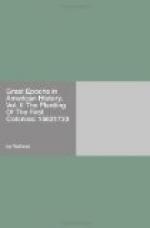Roger Ludlow was Endicott’s brother-in-law. He came to New England in 1630, and settled at Dorchester. He was deputy governor in 1634, and seems to have been “slated,” to use the modern term, for the governorship in the following year. But this private agreement among the deputies was broken, for some unknown reason, by the voters, who chose Haynes, perhaps as a less objectionable representative of the opposition. Ludlow complained so openly and angrily of the failure to carry out the agreement that he was dropped from the magistracy at the next election. He went at once to Connecticut, and was deputy governor there in alternate years until 1654. Incensed at the interference of New Haven to prevent his county, Fairfield, from waging an independent warfare against the Dutch, he went to Virginia in 1654, taking the records of the county with him. It is not known when or where he died. Pynchon, the third lay leader of the opposition, took part in the migration, but remained within the jurisdiction of Massachusetts, founding the town of Springfield.
At the May session of the Massachusetts General Court in 1634, an application for “liberty to remove” was received from Newtown. It was granted. At the September session the request was changed into one for removal to Connecticut. This was a very different matter, and, after long debate, was defeated by the vote of the Assistants, tho the Deputies passed it. Various reasons were assigned for the request to remove to Connecticut,—lack of room in their present locations, the desire to save Connecticut from the Dutch, and “the strong bent of their spirits to remove thither;” but the last looks like the strongest reason. In like manner, while the arguments to the contrary were those which would naturally suggest themselves, the weakening of Massachusetts, and the peril of the emigrants, the concluding argument, that “the removing of a candlestick” would be “a great judgment,” seems to show the feeling of all parties that the secession was the result of discord between two parties.
Haynes was made governor at the next General Court. Successful inducements were offered to some of the Newtown people to remove to Boston, and some few concessions were made. But the migration which had been denied to the corporate towns had probably been begun by individuals. There is a tradition that some of the Watertown people passed this winter of 1634-35 at the place where Wethersfield now stands. In May, 1635, the Massachusetts General Court voted that liberty be granted to the people of Watertown and Roxbury to remove themselves to any place within the jurisdiction of Massachusetts. In March, 1636, the secession having already been accomplished, the General Court issued a “Commission to Several Persons to govern the people at Connecticut.”




